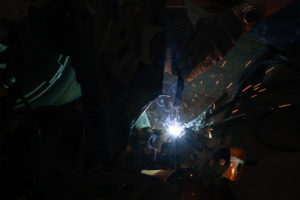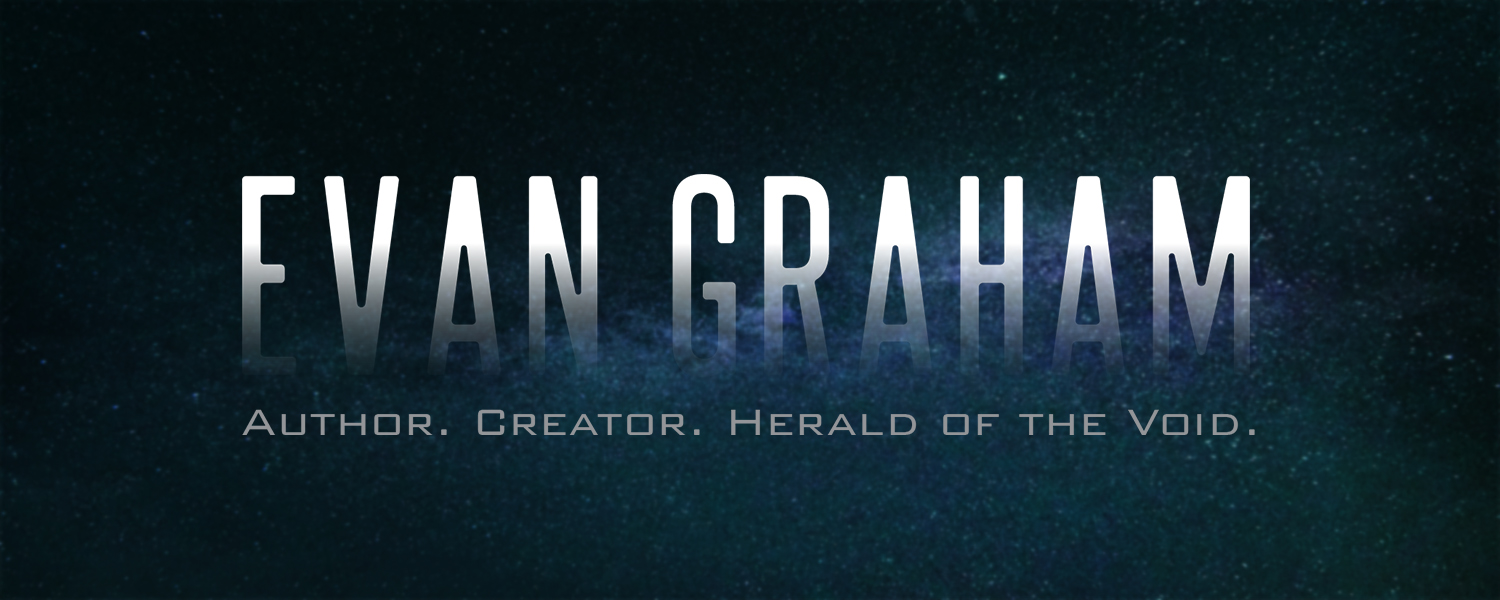The Aftothysian Movement

“We’re the locusts of the galaxy. We’ll never stop feasting until we’ve picked every world clean to the bone.“
~Dr. David Whitcliff
The Aftothysian Movement is a non-governmental activist organization dedicated to the opposition of planetary colonization. The Movement is broad in scope and has many sub-factions with different notions of what the Movement’s actual aims and methods should be, but all are unified in the opinion that humankind should remain anchored to Earth and should leave the rest of the galaxy untouched.
While the majority of the Movement’s actions are nonviolent, Aftothysian extremists have been known to commit various forms of ecoterrorism. These acts often include sabotage of supply lines from Earth to offworld colonies, attacks on remote shipping lanes, or even direct armed assaults on exoplanetary colonies. The Aftothysian Movement is quick to disavow the actions of these extremists as rogue elements acting without official sanction of the Movement, but these acts occur with such frequency that many view the Aftothysian Movement as little more than a terrorist network barely hidden behind a thin mask of legitimacy.
The Aftothysian Movement’s origins can be traced to the twilight years of the 21st century, in the gradual convergence of two unlikely bedfellows with seemingly incompatible ideologies: religious conservatives and environmental activists.
Decades of largely unchecked industrialization had begun to take a serious toll on the Earth’s environment, its oceans rising and filling with garbage as the land was ravaged by increasingly devastating storms, floods, and wildfires. Industrialists continued to use all their political leverage to oppose climate reforms and made only token gestures to police themselves, even as the world threatened to become unlivable in their lifetimes. As the future came to look bleaker by the day, climate activists grew bolder and more desperate, leading to a rise in ecoterrorism.
At the same time, a vocal minority of right-wing evangelicals began protesting recent advancements in AI technology. As AIs grew more ubiquitous and came closer to matching human intellect and conversational ability, conservative wings of several faiths decried them as mockeries of God’s creation, or blasphemous attempts of man to play God. They believed the rapidly approaching technological singularity would be a new Tower of Babel, and that humanity’s attempts to imitate God would be met with divine retribution on a devastating scale.
The two groups could not have been more ideologically distant, and likely would have remained on opposite ends of the political spectrum if not for the ultimate catalyst: the Corsica Event.
The global cataclysm was the perfect embodiment of both groups’ fears. For the environmentalists, unregulated industry had finally produced something so devastating it caused an extinction-level event overnight, leaving the entire Earth permanently disfigured. For the evangelicals, an AI had been created that not only imitated man, but God himself with the scope of its power, culminating in a great flood that killed untold millions. Both groups felt their fears had been fully vindicated, and the rest of the world was in too much disarray to say otherwise.
For several years after the Corsica Event, the discourse of both groups faded from the public eye. They were no longer minority voices. The damage to the Earth’s environment was too extreme to ignore, and many of the corporations responsible for fighting against climate reform lost their power as economies and governments fell and reformed around them. It was no longer seen as superstitious or alarmist to fear the capabilities of advanced AIs, and new restrictions on AI technology came by massive popular demand. Activism from both original groups seemed largely unnecessary now that their causes had become mainstream.
Then came the second catalyzing event: the invention of mass de-simulation technology and the superluminal drive. Suddenly, what had seemed a fantasy for centuries had become a reality: humankind could finally take to the stars and become an interstellar civilization.
For most, this discovery brought hope for a brighter future, but for a small, strange minority, it meant something else entirely. In the time since the Corsica Event, a subcommunity had formed in the intersection between the environmentalist and evangelical factions of the past. This community believed the Corsica Event was more than an ecological tragedy or a punishment from God: it was a preview of humanity’s inevitable self-destruction. The Corsica Event was proof of humankind’s inherent destructiveness to its own environment.
Thus a new activist group was formed, unified not by faith or desperation, but by shared nihilism. They called themselves Aftothysians, taking their name from the Greek term for heroic self-sacrifice, reflecting the grim new purpose they had set for themselves.
Believing humankind destined to destroy everything in its reach, Aftothysians found their calling in limiting that reach at any cost. Humanity had already ravaged its homeworld beyond repair; now that it could travel to other worlds with ease, it would surely spread that destruction wherever it went. Aftothysians united in a common goal to quarantine humanity in its own solar system to spare the rest of the galaxy from its devastating influence, even if doing so meant humanity’s ultimate demise.

On its public face, the Aftothysian Movement is a peaceful, loosely-organized environmentalist group that seeks to turn humanity’s focus from expansion among the stars to restoration of its homeworld, and most of its followers are nonviolent in pursuit of this cause. However, certain sects of the movement carry its goals to the point of full-blown ecoterrorism.
Aftothysian extremists have been found responsible for everything from sabotage, to piracy, to illegal armsdealing, to assassinations, all with the aim of hindering or outright destroying colonization efforts on other worlds, particularly outside our own solar system. The main organizers of the movement publically denounce all such acts, but many believe the Aftothysian leadership knows more about the movements and activities of the extremist wing than they let on, and seem at least to do little to stop them.
Despite their commitment to limiting humanity’s presence on other worlds, Aftothysians operate on every colonized world. The largest Aftothysian group, a quasi-religious organization called the Dusk Fellowship, holds its headquarters on Showalter in a massive arcology dome called the Cathedral of the Dignified End. As Showalter is the fastest-growing extrasolar colony world, many of its most aggressive activities occur there.

The Aftothysian Movement

“We’re the locusts of the galaxy. We’ll never stop feasting until we’ve picked every world clean to the bone.“
~Dr. David Whitcliff
The Aftothysian Movement is a non-governmental activist organization dedicated to the opposition of planetary colonization. The Movement is broad in scope and has many sub-factions with different notions of what the Movement’s actual aims and methods should be, but all are unified in the opinion that humankind should remain anchored to Earth and should leave the rest of the galaxy untouched.
While the majority of the Movement’s actions are nonviolent, Aftothysian extremists have been known to commit various forms of ecoterrorism. These acts often include sabotage of supply lines from Earth to offworld colonies, attacks on remote shipping lanes, or even direct armed assaults on exoplanetary colonies. The Aftothysian Movement is quick to disavow the actions of these extremists as rogue elements acting without official sanction of the Movement, but these acts occur with such frequency that many view the Aftothysian Movement as little more than a terrorist network barely hidden behind a thin mask of legitimacy.
The Aftothysian Movement’s origins can be traced to the twilight years of the 21st century, in the gradual convergence of two unlikely bedfellows with seemingly incompatible ideologies: religious conservatives and environmental activists.
Decades of largely unchecked industrialization had begun to take a serious toll on the Earth’s environment, its oceans rising and filling with garbage as the land was ravaged by increasingly devastating storms, floods, and wildfires. Industrialists continued to use all their political leverage to oppose climate reforms and made only token gestures to police themselves, even as the world threatened to become unlivable in their lifetimes. As the future came to look bleaker by the day, climate activists grew bolder and more desperate, leading to a rise in ecoterrorism.
At the same time, a vocal minority of right-wing evangelicals began protesting recent advancements in AI technology. As AIs grew more ubiquitous and came closer to matching human intellect and conversational ability, conservative wings of several faiths decried them as mockeries of God’s creation, or blasphemous attempts of man to play God. They believed the rapidly approaching technological singularity would be a new Tower of Babel, and that humanity’s attempts to imitate God would be met with divine retribution on a devastating scale.
The two groups could not have been more ideologically distant, and likely would have remained on opposite ends of the political spectrum if not for the ultimate catalyst: the Corsica Event.
The global cataclysm was the perfect embodiment of both groups’ fears. For the environmentalists, unregulated industry had finally produced something so devastating it caused an extinction-level event overnight, leaving the entire Earth permanently disfigured. For the evangelicals, an AI had been created that not only imitated man, but God himself with the scope of its power, culminating in a great flood that killed untold millions. Both groups felt their fears had been fully vindicated, and the rest of the world was in too much disarray to say otherwise.
For several years after the Corsica Event, the discourse of both groups faded from the public eye. They were no longer minority voices. The damage to the Earth’s environment was too extreme to ignore, and many of the corporations responsible for fighting against climate reform lost their power as economies and governments fell and reformed around them. It was no longer seen as superstitious or alarmist to fear the capabilities of advanced AIs, and new restrictions on AI technology came by massive popular demand. Activism from both original groups seemed largely unnecessary now that their causes had become mainstream.
Then came the second catalyzing event: the invention of mass de-simulation technology and the superluminal drive. Suddenly, what had seemed a fantasy for centuries had become a reality: humankind could finally take to the stars and become an interstellar civilization.
For most, this discovery brought hope for a brighter future, but for a small, strange minority, it meant something else entirely. In the time since the Corsica Event, a subcommunity had formed in the intersection between the environmentalist and evangelical factions of the past. This community believed the Corsica Event was more than an ecological tragedy or a punishment from God: it was a preview of humanity’s inevitable self-destruction. The Corsica Event was proof of humankind’s inherent destructiveness to its own environment.
Thus a new activist group was formed, unified not by faith or desperation, but by shared nihilism. They called themselves Aftothysians, taking their name from the Greek term for heroic self-sacrifice, reflecting the grim new purpose they had set for themselves.
Believing humankind destined to destroy everything in its reach, Aftothysians found their calling in limiting that reach at any cost. Humanity had already ravaged its homeworld beyond repair; now that it could travel to other worlds with ease, it would surely spread that destruction wherever it went. Aftothysians united in a common goal to quarantine humanity in its own solar system to spare the rest of the galaxy from its devastating influence, even if doing so meant humanity’s ultimate demise.

On its public face, the Aftothysian Movement is a peaceful, loosely-organized environmentalist group that seeks to turn humanity’s focus from expansion among the stars to restoration of its homeworld, and most of its followers are nonviolent in pursuit of this cause. However, certain sects of the movement carry its goals to the point of full-blown ecoterrorism.
Aftothysian extremists have been found responsible for everything from sabotage, to piracy, to illegal armsdealing, to assassinations, all with the aim of hindering or outright destroying colonization efforts on other worlds, particularly outside our own solar system. The main organizers of the movement publically denounce all such acts, but many believe the Aftothysian leadership knows more about the movements and activities of the extremist wing than they let on, and seem at least to do little to stop them.
Despite their commitment to limiting humanity’s presence on other worlds, Aftothysians operate on every colonized world. The largest Aftothysian group, a quasi-religious organization called the Dusk Fellowship, holds its headquarters on Showalter in a massive arcology dome called the Cathedral of the Dignified End. As Showalter is the fastest-growing extrasolar colony world, many of its most aggressive activities occur there.
“We’re the locusts of the galaxy. We’ll never stop feasting until we’ve picked every world clean to the bone.“
~Dr. David Whitcliff
The Aftothysian Movement is a non-governmental activist organization dedicated to the opposition of planetary colonization. The Movement is broad in scope and has many sub-factions with different notions of what the Movement’s actual aims and methods should be, but all are unified in the opinion that humankind should remain anchored to Earth and should leave the rest of the galaxy untouched.
While the majority of the Movement’s actions are nonviolent, Aftothysian extremists have been known to commit various forms of ecoterrorism. These acts often include sabotage of supply lines from Earth to offworld colonies, attacks on remote shipping lanes, or even direct armed assaults on exoplanetary colonies. The Aftothysian Movement is quick to disavow the actions of these extremists as rogue elements acting without official sanction of the Movement, but these acts occur with such frequency that many view the Aftothysian Movement as little more than a terrorist network barely hidden behind a thin mask of legitimacy.
The Aftothysian Movement’s origins can be traced to the twilight years of the 21st century, in the gradual convergence of two unlikely bedfellows with seemingly incompatible ideologies: religious conservatives and environmental activists.
Decades of largely unchecked industrialization had begun to take a serious toll on the Earth’s environment, its oceans rising and filling with garbage as the land was ravaged by increasingly devastating storms, floods, and wildfires. Industrialists continued to use all their political leverage to oppose climate reforms and made only token gestures to police themselves, even as the world threatened to become unlivable in their lifetimes. As the future came to look bleaker by the day, climate activists grew bolder and more desperate, leading to a rise in ecoterrorism.
At the same time, a vocal minority of right-wing evangelicals began protesting recent advancements in AI technology. As AIs grew more ubiquitous and came closer to matching human intellect and conversational ability, conservative wings of several faiths decried them as mockeries of God’s creation, or blasphemous attempts of man to play God. They believed the rapidly approaching technological singularity would be a new Tower of Babel, and that humanity’s attempts to imitate God would be met with divine retribution on a devastating scale.
The two groups could not have been more ideologically distant, and likely would have remained on opposite ends of the political spectrum if not for the ultimate catalyst: the Corsica Event.
The global cataclysm was the perfect embodiment of both groups’ fears. For the environmentalists, unregulated industry had finally produced something so devastating it caused an extinction-level event overnight, leaving the entire Earth permanently disfigured. For the evangelicals, an AI had been created that not only imitated man, but God himself with the scope of its power, culminating in a great flood that killed untold millions. Both groups felt their fears had been fully vindicated, and the rest of the world was in too much disarray to say otherwise.
For several years after the Corsica Event, the discourse of both groups faded from the public eye. They were no longer minority voices. The damage to the Earth’s environment was too extreme to ignore, and many of the corporations responsible for fighting against climate reform lost their power as economies and governments fell and reformed around them. It was no longer seen as superstitious or alarmist to fear the capabilities of advanced AIs, and new restrictions on AI technology came by massive popular demand. Activism from both original groups seemed largely unnecessary now that their causes had become mainstream.
Then came the second catalyzing event: the invention of mass de-simulation technology and the superluminal drive. Suddenly, what had seemed a fantasy for centuries had become a reality: humankind could finally take to the stars and become an interstellar civilization.
For most, this discovery brought hope for a brighter future, but for a small, strange minority, it meant something else entirely. In the time since the Corsica Event, a subcommunity had formed in the intersection between the environmentalist and evangelical factions of the past. This community believed the Corsica Event was more than an ecological tragedy or a punishment from God: it was a preview of humanity’s inevitable self-destruction. The Corsica Event was proof of humankind’s inherent destructiveness to its own environment.
Thus a new activist group was formed, unified not by faith or desperation, but by shared nihilism. They called themselves Aftothysians, taking their name from the Greek term for heroic self-sacrifice, reflecting the grim new purpose they had set for themselves.
Believing humankind destined to destroy everything in its reach, Aftothysians found their calling in limiting that reach at any cost. Humanity had already ravaged its homeworld beyond repair; now that it could travel to other worlds with ease, it would surely spread that destruction wherever it went. Aftothysians united in a common goal to quarantine humanity in its own solar system to spare the rest of the galaxy from its devastating influence, even if doing so meant humanity’s ultimate demise.

On its public face, the Aftothysian Movement is a peaceful, loosely-organized environmentalist group that seeks to turn humanity’s focus from expansion among the stars to restoration of its homeworld, and most of its followers are nonviolent in pursuit of this cause. However, certain sects of the movement carry its goals to the point of full-blown ecoterrorism.
Aftothysian extremists have been found responsible for everything from sabotage, to piracy, to illegal armsdealing, to assassinations, all with the aim of hindering or outright destroying colonization efforts on other worlds, particularly outside our own solar system. The main organizers of the movement publically denounce all such acts, but many believe the Aftothysian leadership knows more about the movements and activities of the extremist wing than they let on, and seem at least to do little to stop them.
Despite their commitment to limiting humanity’s presence on other worlds, Aftothysians operate on every colonized world. The largest Aftothysian group, a quasi-religious organization called the Dusk Fellowship, holds its headquarters on Showalter in a massive arcology dome called the Cathedral of the Dignified End. As Showalter is the fastest-growing extrasolar colony world, many of its most aggressive activities occur there.





